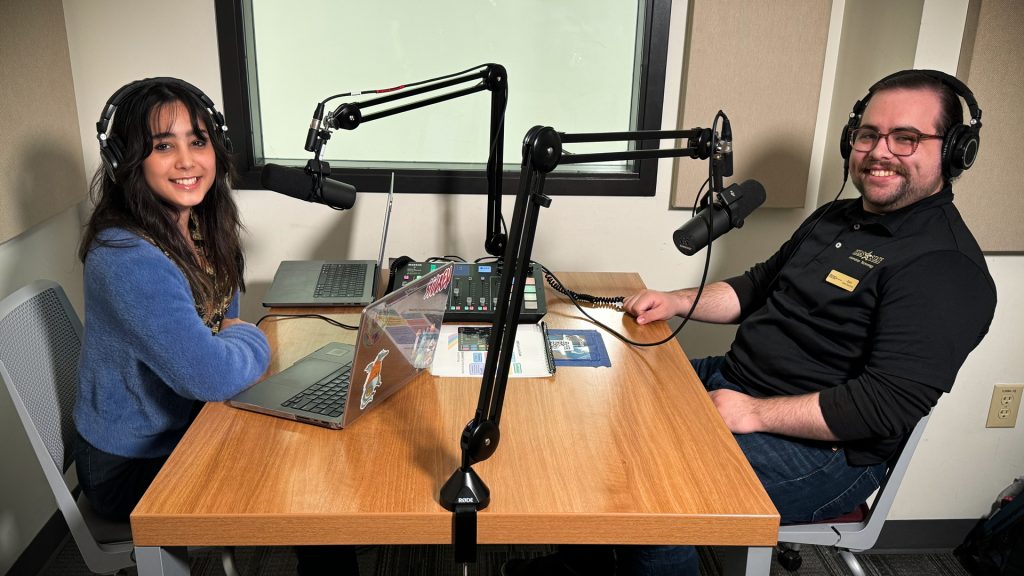Check out the first episode of “Tech Deep Dive,” TXST Information Technology’s podcast program. In this episode, IT student worker Sophie Reel is in conversation with Zach Johnson of the IT Assistance Center. Listen to the full episode here and read highlights below. Thanks for listening!
“Tech Deep Dive” delves into the amazing technology that is transforming Texas State University. Join us monthly as we converse about everything tech at TXST.
Listen to the episode:
Meet Zach Johnson
Sophie: Hi, Bobcats. My name is Sophie, and I will be your host for today’s episode. I’m an IT student worker, and joining me today is Zach, who works at the IT Assistance Center on the first floor of Alkek Library. Today, Zach will be sharing some insights about working at the IT Assistance Center. Welcome to the podcast, Zach. Please, before we start, could you share with us a bit about yourself?
Zach: Of course. My name is Zach. I’m a user services consultant at the ITAC desk down in Alkek One. I manage students as well as help out at the desk myself, so you’ll often see me up there helping users or assisting my student workers with various kinds of technology needs.
Popular help desk requests
Sophie: So Zach, what are the top three requests you get from customers?
Zach: The first one has got to be Wi-Fi. So, with Texas State Wi-Fi, there are several different kinds. There’s Visitor, there’s Bobcats, and there’s Home. All three are used for different purposes. You know Home is for dorms, Bobcats is for students, and Visitors is for visitors. Most of the time, we get a lot of Wi-Fi questions at the beginning of semesters because we have so many students on campus. It can sometimes overload our Wi-Fi access points just because, you know, they can only handle so many people in the given area at a time. We also generally recommend that students, faculty, and staff use Bobcats exclusively, unless, of course, they’re in a dorm. In which case, there’s Home, but that’s generally for things like TVs or Xboxes. Visitors’ Wi-Fi is usually not our recommended one for people who are on campus consistently or have login information, just because it’s not really made for a lot of people. So when people connect to it, it can cause their computers to run slower; it can take longer for websites to pop up. It’s going to constantly ask you to log back in with your phone number. So Bobcats, 100%, that’s the one that you should be using.
Second, definitely Duo. Duo is our authentication tool that we use for logging in. Its main purpose is making sure that students’ data doesn’t get stolen if their password gets leaked, and the way that works is basically it will call, text, or send a notification to your phone alerting you that someone’s logging in as you, and of course if it’s you, press accept. If it’s not, then deny, and probably change your password. Most of the questions we get about those is, what is it? How does it work? Can I change my phone number? Can I add my computer as a device – that kind of stuff.
The last one is definitely malware. We have a lot of people coming to the desk because they have a virus on their computer, and they need it removed. Or, you know, they have adware popping up on one of their browsers. We provide a free service to all students called ResNet through residential life. We remove viruses for free at the desk using our software. Unfortunately for staff and faculty, it is not free for them. It is only for students, so if a faculty or staff have viruses that can’t just be removed by clearing a browser’s cache, then we usually tell them to check the device in so we can have our hardware technicians take a look at it.
A funny story
Sophie: What about a hilarious or memorable moment you might have experienced?
Zach: So this one happens every so often, so it’s sort of a recurring funny story. On Lenovo computers, sometimes the brightness will go all the way down, and when the brightness is all the way down, it’s a completely black screen. I mean, you can’t see anything. And so we’ll have people coming to the desk freaking out saying, oh my God, my computer won’t turn on, or it’s turning on, but the screen’s black. What’s happening? Is my computer broken? The first couple of times it happened, I spent about 20 minutes trying to figure out why the screen was black, doing all kinds of troubleshooting. Then my boss, Peter, came up behind me and, with one finger, pressed the brightness button and turned the screen back on. And I’m like, well, that was 20 minutes wasted, but at least we know your computer is not broken. Yeah, sometimes things are much easier than they seem. It’s always easier or harder. It’s never exactly the way you think it’s going to be.
Favorite TXST tech
Sophie: Out of everything you’ve seen behind the desk, what’s your favorite tech tool?
Zach: For sure, it has to be the TXST Mobile app—specifically the map function. It allows you to route destinations across campus using pre-planned routes. The function I like the most is its ability to show you accessibility routes, which are ramps instead of stairs. I used to be a self-defense instructor, and as a result, I have not-so-good joints, and sometimes I just don’t want to deal with stairs, and ramps are much easier to go down. So I’ll just take out my phone, open the app, go to the accessibility mode on the map, and then find an alternate route.
Catch the rest of the conversation at the link above!
IT Communications and Outreach staff Paul Collins, Sophie Reel, and Angela Smith contributed to this post and production.


